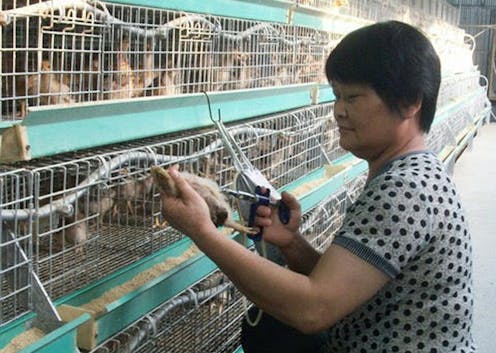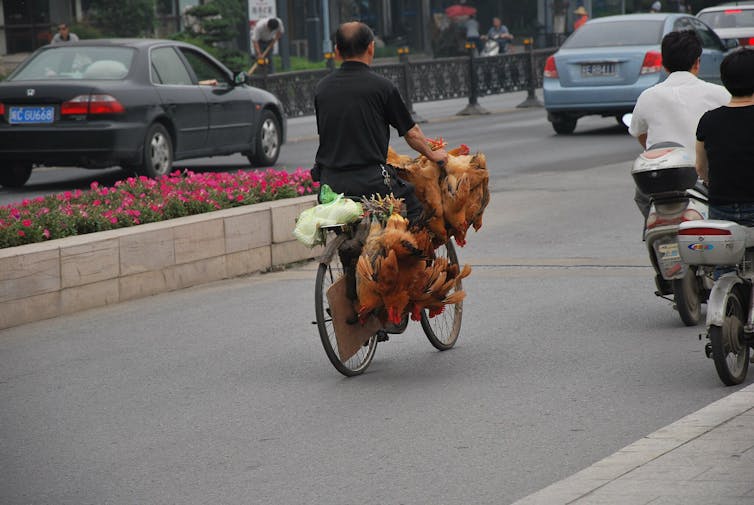
Of all the recently emerging and potentially pandemic viruses, the highly pathogenic avian influenza (HPAI) virus H5N1 is one of the fiercest. First detected in Hong Kong in 1997, it spread to the rest of the world with a mortality rate of 60% when transmitted from birds to humans. The World Health Organization has declared in August 2023 that 878 cases and 458 deaths were recorded since 1997.
The past two years have seen a new strain of the virus circulate among wild birds and domestic poultry in Europe and the Americas, with high avian mortality. So far, humans appear to have been spared, with five cases recorded since early 2023. International health authorities are however keeping a close eye on mutations of the virus and prescribing strict measures to control its spread.
But French health authorities are also not standing idle, green-lighting avian flu vaccination in the country for the first time and introducing innovative monitoring schemes. The country’s agricultural sector is in no mood to take risks, after the last outbreak of H5N1 in 2022 resulted in the slaughter of 21 million birds in France at an estimated cost of 1.5 billion euros. At the time, health services who came to “depopulate” buildings were so overwhelmed by the scale of the task that many farmers had to euthanise their poultry themselves, sometimes with no other means than cutting off ventilation in the buildings. These culls undermined not only the viability of the poultry industry, but also animal-welfare standards and farmers’ morale.
Disparities between large and small farms
French health authorities imposed containment and hygiene measures (respectively referred to as “sheltering” and “biosecurity”) on poultry farms to protect them from the risk of transmission of avian flu by wild birds. As highlighted in a report by the French National Assembly, these measures have had a significant negative impact on small-scale free-range poultry farms, as large-scale industrial operations were more easily able to integrate the costs.
The Confédération Paysanne, France’s progressive farmers’ union, negotiated with the health authorities for measures adapted to small-scale outdoor farming. Both the Assembly’s rapporteurs and the farmers’ unions point out that genetic diversity on small farms can provide a form of immunity against emerging viruses. This is not the case with closed farms, where biosecurity measures can accentuate the vulnerability of poultry, which are genetically standardised and weakened by the use of antibiotics.
France introduces avian vaccination
After the massive slaughters of spring 2022, poultry farmers have asked health authorities to make avian flu vaccination accessible. Until recently, European regulation prohibited such vaccination, as it makes it impossible to know whether exported poultry are virus free, but this ban was lifted this year. In Asia, countries such as China and Vietnam with high levels of domestic poultry consumption vaccinate their flocks against bird flu, while those with high exports, such as Thailand, do not. In France, 40% of the value produced by the poultry sector comes from exports, even though half the poultry meat consumed is imported. Only birds raised in French zoos are vaccinated.
The French National Agency for Health Safety, Anses, has tried experiments on the vaccination of ducks that carry avian flu viruses asymptomatically. These experiments were first made on small farms in southwest France, then in animal houses at a laboratory in Brittany. The results were deemed sufficiently positive for the Ministry of Agriculture to announce a vaccination campaign for farmed ducks in autumn 2023, allowing for a manufacturing time of 6 to 8 months.

The technical difficulty of vaccinating poultry lies in their short lifespan compared to other farm animals (around 60 days) and the fact that two doses are required for the vaccine to be effective. Farmers point out that the first dose can be injected at birth (as is the case for vaccination against Newcastle disease), but pharmaceutical laboratories estimate that 75% of the cost of vaccination is due to vaccine handling and post-vaccination follow-up. Vaccination cannot be carried out on a large scale in France because of the diversity of avian species and viral strains.
Anses has issued the following recommendations:
Vaccination of ducks as a preventive and experimental measure.
Vaccination of poultry in the event of an outbreak of H5N1 as an emergency measure.
When a bird flu outbreak is detected in a vaccinated areas, only the affected farm should be culled, not those nearby.
Experts point out that vaccination will not enable health authorities to avoid other sanitary measures, such as surveillance of virus strains in normal times and culling of poultry in emergencies. Vaccination mishaps risks of releasing strains of H5N1, which can mutate and amplify in the ecological niche opened up by the destruction of other strains.
Sentinel chickens
The DIVA (Differentiating Infected from Vaccinated Animals) system is prescribed by health authorities to distinguish between viruses introduced by vaccination and those that herald a new outbreak of infection. This system may be inspired by measures adopted in Hong Kong, where unvaccinated chickens are placed at farm entrances to act as sentinels. The Chinese term shaobingji refers to these chickens are “soldiers” who sound the alarm on the presence of the virus.
Nevertheless, vaccination offers farmers the hope of reestablishing a “domestic contract” with their poultry, between the daily anguish of finding a sick bird and the desolation of having to slaughter an entire “batch”. The terms of the bird flu debate – between containment and vaccination – seem to replay the one that took place around Covid-19 three years earlier, as if human and avian populations were subject to the same “biopolitics” consisting, in Michel Foucault’s words, of “making populations live and letting them die”.
When animals are vaccinated, they cease to be perceived as commodities that can be slaughtered in the event of a defect. Instead, they once again become living beings who are cared for because of the risk to their species and ours.
Wildfowl and domestic poultry
The experts’ insistence on the need to continue monitoring wild birds and domestic poultry also shows that vaccination, while it may lighten the moral burden on poultry farmers, in no way solves the ecological problems posed by export-oriented industrial farming.
Against a backdrop of climate change, which is also affecting wild birds’ migratory trajectories, poultry farmers can play the role of sentinels by reporting cases of sick birds found in their fields. The French Office for Biodiversity and the League for the Protection of Birds have pointed out that the number of wild birds carrying bird flu has increased to such an extent that wildlife specialists will be unable to count them.
Experts are not yet talking about vaccinating wild birds against influenza, something that would be technically impossible and morally dubious. However, bird flu has not only forced health authorities to innovate in prevention and containment strategies, but has also blurred the divide that has long separated livestock management and wildlife surveillance.

Created in 2007 to help accelerate and share scientific knowledge on key societal issues, the AXA Research Fund has supported nearly 700 projects around the world conducted by researchers in 38 countries. To learn more, visit the site of the AXA Research Fund or follow on Twitter @AXAResearchFund.
Frédéric Keck has received funding from the Axa Research Fund, the Agence nationale de la recherche, DIM One Health and the Canadian Institute for Advanced Rese
This article was originally published on The Conversation. Read the original article.







